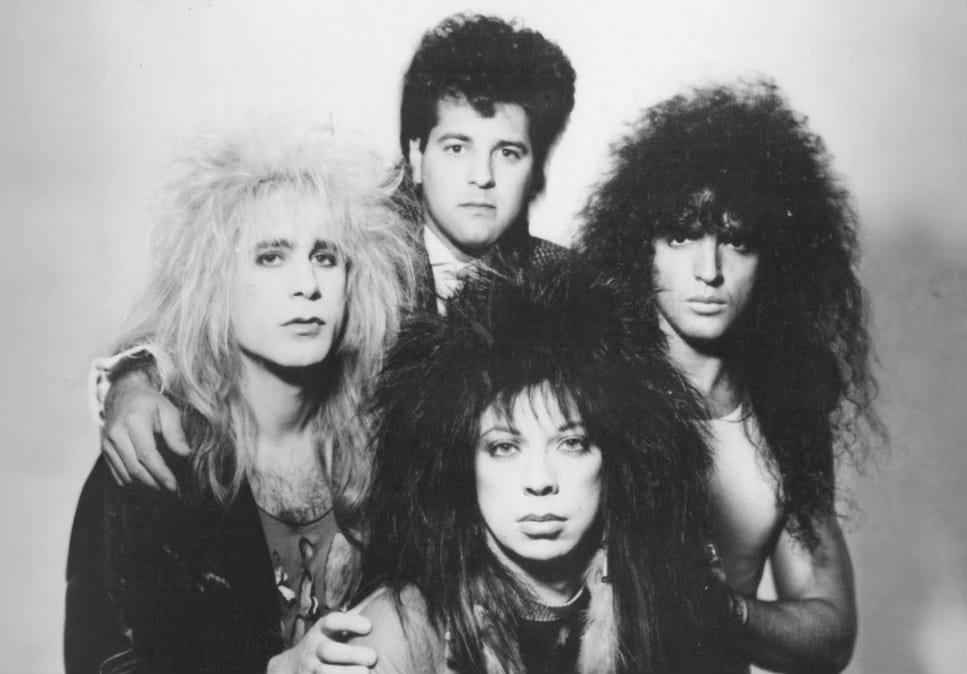Vinnie Vincent Invasion | History of the Band
Riffs and Drama: A Rollercoaster Journey from KISS Legacy to Self-Destruction
Formed in 1984 after Vinnie Vincent departed from Kiss, Vinnie Vincent Invasion emerged as a spectacle of glam metal with a distinct edge. Alongside Vincent, the original lineup included vocalist Robert Fleischman, bassist Dana Strum, and drummer Bobby Rock. Their foundation was built on a shared ambition to push the boundaries of the glam metal genre, incorporating intense guitar solos and theatrical performances.
Deren Svendsen suggested this artist for a future Dig Me Out podcast episode. Each month, our Patrons are presented with a selection of albums suggested by listeners and asked to vote for their favorite.
Musical Style and Evolution
Vinnie Vincent Invasion initially embraced the flamboyant style of glam metal but soon incorporated heavy metal elements, making their sound more aggressive and technically complex. Vincent's shredding guitar style became a signature of the band, distinguishing them within the rock music scene of the 1980s as they evolved to match the intensity of their live performances with their studio recordings.
Discography and Notable 80s Albums
"Vinnie Vincent Invasion" (1986): Released under Chrysalis Records, the debut album exploded onto the metal scene with tracks like "Boyz Are Gonna Rock" and "Animal". It was celebrated for Vincent’s over-the-top guitar virtuosity and the band's energetic execution. Critics noted the album's "blistering pace and wild solos as a return to form for Vincent," according to AllMusic. Despite criticism for its relentless pace, the album carved out a significant place for the band in glam metal. It achieved moderate commercial success, peaking on the Billboard 200 and solidifying the band's presence in the metal community.
"All Systems Go" (1988): This follow-up saw a lineup change with the introduction of Mark Slaughter on vocals, bringing a different sound and energy to the band. The album featured more melodic tracks like "Love Kills" and "That Time of Year", which resonated well with audiences and showed a maturation in their songwriting. Despite mixed reviews from critics, who sometimes found the shift in style jarring, fan reception was largely positive, particularly for the emotionally charged "Love Kills" which became a minor hit. Released again by Chrysalis Records, the album further demonstrated the band’s ability to evolve within the glam metal genre.
Influence and Legacy
The critical reception of the Vinnie Vincent Invasion was mixed. While the musicians' technical skill, particularly Vincent's guitar work, was widely praised, some critics and listeners felt the band's style was too excessive. Nevertheless, their bold approach and Vincent’s prowess earned them a dedicated fan base and a respected place in the genre.
After Vinnie Vincent Invasion disbanded in 1989, the members pursued various musical and professional endeavors that continued to influence the rock and metal scenes:
Vinnie Vincent largely retreated from the public eye, although he has occasionally resurfaced with occasional live performances and involvement in the music industry.
Mark Slaughter and Dana Strum went on to form the band Slaughter, which achieved significant commercial success. Their debut album, Stick It to Ya, released in 1990, was certified 2× Platinum by the RIAA. The band continues to tour and has a loyal fan base.
Robert Fleischman, the original vocalist for Vinnie Vincent Invasion, continued his solo career, releasing several albums and exploring genres beyond rock, including ambient and film-scoring music.
Bobby Rock, the drummer, became a recognized figure in the health and fitness community and his music career. He has played with numerous other bands, authored books on drumming, and remains an active performer and clinician.
Vinnie Vincent Invasion epitomized the excess and experimentation of the 1980s metal scene. Their albums, while only a part of their brief but bright career, showcased a band unafraid to push boundaries and explore new musical territories. Their legacy, marked by incredible highs and tumultuous lows, remains a fascinating chapter in the story of 80s and early 90s music, capturing a moment when metal was as much about the spectacle as the sound.



